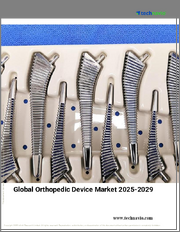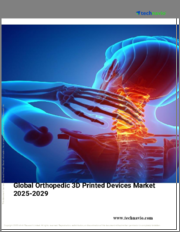
|
시장보고서
상품코드
1677953
세계의 정형외과용 기기 시장 규모, 점유율, 성장 분석 : 제품별, 부위별, 용도별, 최종사용자별, 지역별 - 산업 예측(2025-2032년)Orthopedic Devices Market Size, Share, and Growth Analysis, By Product (Orthopedic Fixation Devices, Orthopedic Replacement Devices), By Site (Hip and Pelvis, Foot and Ankle), By Application, By End User, By Region - Industry Forecast 2025-2032 |
||||||
정형외과용 기기 시장 규모는 2023년 544억 7,000만 달러로 평가되었습니다. 또한, 2024년 566억 5,000만 달러에서 2032년에는 775억 3,000만 달러로 확대될 것으로 예상되며, 예측 기간(2025-2032년) 동안 4.0%의 연평균 복합 성장률(CAGR)을 보일 것으로 예측됩니다.
정형외과 기기 시장은 골격 기능을 강화하고 복잡한 수술의 필요성을 줄이는 첨단 기술로 인해 크게 성장하고 있으며, WHO에 따르면 근골격계 질환의 유병률은 연령에 따라 증가하고 있으며, 지리적 격차가 이러한 질환의 발생률에 영향을 미치고 있습니다. 특히 동지중해 지역과 아프리카은 근골격계 질환의 발생률이 높습니다. 업계 리더들은 제품 라인업을 확대한 Wright Medical Group과 Tornier N.V.의 합병, 세계 사업 확장을 강화한 Tecomet Inc.의 Symmetry Medical 인수로 대표되는 합병 및 인수를 통한 성장 전략을 적극적으로 추구하고 있습니다. 하고 있습니다. 또한, 수많은 신제품 출시와 기술 혁신이 정형외과용 기기 분야에 유리한 기회를 창출하고 있어 향후 확장에 대한 유망한 전망을 세우고 있습니다.
목차
서론
- 조사 목적
- 조사 범위
- 정의
조사 방법
- 정보 조달
- 2차와 1차 데이터 방법
- 시장 규모 예측
- 시장 전제조건과 제한
주요 요약
- 세계 시장 전망
- 공급과 수요 동향 분석
- 부문별 기회 분석
시장 역학과 전망
- 시장 개요
- 시장 규모
- 시장 역학
- 성장 촉진요인과 기회
- 성장 억제요인과 과제
- Porter의 Five Forces 분석
주요 시장 인사이트
- 중요 성공 요인
- 경쟁 정도
- 주요 투자 기회
- 시장 생태계
- 시장의 매력 지수(2024년)
- PESTEL 분석
- 거시경제 지표
- 밸류체인 분석
- 가격 분석
- 기술 진보
- 사례 연구
정형외과용 기기 시장 규모 : 제품별&CAGR(2025-2032년)
- 시장 개요
- 정형외과용 고정 기기
- 내부 고정 기기
- 외부 고정 기기
- 정형외과용 치환 기기
- 발목 치환 기기
- 고관절 치환 기기
- 슬관절 치환 기기
- 견관절 치환 기기
- 주관절 치환 기기
- 손목 치환 기기
- 정형외과용 보철
- SACH 유형 보철
- 단축 보철
- 다축 보철
- 동적 반응 보철
- 마이크로프로세서 제어 보철
- 정형외과용 보조기 및 지지대 제품
- 발목 보조기 및 지지대 제품
- 무릎 보조기 및 지지대 제품
- 족용 보행기와 장비
- 허리, 엉덩이, 척추 보조기 및 지지대 제품
- 어깨 보조기 및 지지대 제품
- 팔꿈치 보조기 및 지지대 제품
- 손 및 손목 보조기 및 지지대 제품
- 안면 보조기 및 지지대 제품
- 척추 임플란트 및 외과용 기기
- 척추 고정 기기
- 척추 비고정 기기
- 관절경 검사 기구
- 오소바이오로직스
- 골이식 대체품
정형외과용 기기 시장 규모 : 부위별&CAGR(2025-2032년)
- 시장 개요
- 고관절 및 골반
- 다리 및 발목
- 무릎 및 허벅지
- 손 및 손목
- 어깨
- 팔 및 팔꿈치
- 척추
- 두개악안면
정형외과용 기기 시장 규모 : 용도별&CAGR(2025-2032년)
- 시장 개요
- 골절 치료 및 회복
- 류마티스 관절염 및 골관절염
- 인대 손상
- 신경질환
- 당뇨병성 족부 질환
- 척추 유합, 고정 및 감압술
정형외과용 기기 시장 규모 : 최종사용자별&CAGR(2025-2032년)
- 시장 개요
- 병원 및 외과 센터
- 정형외과 클리닉
- 외래 및 외상 케어 센터
- 홈케어
- 기타 최종사용자
정형외과용 기기 시장 규모 : 지역별&CAGR(2025-2032년)
- 북미
- 미국
- 캐나다
- 유럽
- 독일
- 스페인
- 프랑스
- 영국
- 이탈리아
- 기타 유럽
- 아시아태평양
- 중국
- 인도
- 일본
- 한국
- 기타 아시아태평양
- 라틴아메리카
- 브라질
- 기타 라틴아메리카
- 중동 및 아프리카
- GCC 국가
- 남아프리카공화국
- 기타 중동 및 아프리카
경쟁 정보
- 주요 5개사 비교
- 주요 기업의 시장 포지셔닝(2024년)
- 주요 시장 기업이 채택한 전략
- 최근 시장 동향
- 기업의 시장 점유율 분석(2024년)
- 주요 기업 개요
- 기업 상세
- 제품 포트폴리오 분석
- 기업 부문별 점유율 분석
- 매출 전년대비 비교(2022-2024년)
주요 기업 개요
- Stryker(USA)
- Zimmer Biomet(USA)
- Smith+Nephew(UK)
- Enovis(USA)
- Alphatec(USA)
- Arthrex(USA)
- DJO Global(USA)
- Wright Medical Group(USA)
- Globus Medical(USA)
- NuVasive(USA)
- Orthofix(USA)
- ZimVie(USA)
- Medacta(Switzerland)
- MicroPort Orthopedics(China)
- B. Braun Melsungen(Germany)
결론과 제안
LSH 25.04.21Orthopedic Devices Market size was valued at USD 54.47 billion in 2023 and is poised to grow from USD 56.65 billion in 2024 to USD 77.53 billion by 2032, growing at a CAGR of 4.0% during the forecast period (2025-2032).
The orthopaedic devices market is experiencing significant growth, driven by advanced technologies that enhance skeletal function and reduce the need for complex surgical procedures. According to the WHO, the prevalence of musculoskeletal disorders increases with age, and geographical disparities affect the incidence of these conditions. Notably, the East Mediterranean and African regions show particularly high rates of musculoskeletal disorders. Industry leaders are actively pursuing growth strategies through mergers and acquisitions, exemplified by the merger of Wright Medical Group and Tornier N.V., which expanded their product offerings, and Tecomet Inc.'s acquisition of Symmetry Medical, bolstering their global footprint. Additionally, numerous new product launches and innovations are creating lucrative opportunities in the orthopaedic devices sector, setting a promising outlook for future expansion.
Top-down and bottom-up approaches were used to estimate and validate the size of the Orthopedic Devices market and to estimate the size of various other dependent submarkets. The research methodology used to estimate the market size includes the following details: The key players in the market were identified through secondary research, and their market shares in the respective regions were determined through primary and secondary research. This entire procedure includes the study of the annual and financial reports of the top market players and extensive interviews for key insights from industry leaders such as CEOs, VPs, directors, and marketing executives. All percentage shares split, and breakdowns were determined using secondary sources and verified through Primary sources. All possible parameters that affect the markets covered in this research study have been accounted for, viewed in extensive detail, verified through primary research, and analyzed to get the final quantitative and qualitative data.
Orthopedic Devices Market Segments Analysis
Global Orthopedic Devices Market is segmented by Product, Site, Application, End User and region. Based on Product, the market is segmented into Orthopedic Fixation Devices, Orthopedic Replacement Devices, Orthopedic Prosthetics, Orthopedic Braces and Support Products,Spinal Implants And Surgical Devices, Arthroscopy Instruments, Orthobiologics and Bone Graft Substitutes. Based on Site, the market is segmented into Hip and Pelvis, Foot and Ankle, Knee and Thigh, Hand and Wrist, Shoulder, Arm and Elbow, Spine and Craniomaxillofacial. Based on Application, the market is segmented into Fracture Treatment and Recovery, Rheumatoid Arthritis and Osteoarthritis, Ligament Injuries, Neurological Disorders, Diabetic Foot Diseases and Spinal Fusion, Fixation, and Decompression. Based on End User, the market is segmented into Hospitals and Surgical Centers, Orthopedic Clinics, Ambulatory and Trauma Care Centers, Home Care Settings and Other End Users. Based on region, the market is segmented into North America, Europe, Asia Pacific, Latin America and Middle East & Africa.
Driver of the Orthopedic Devices Market
The orthopedic devices market is significantly shaped by demographic trends, particularly the aging population, which tends to experience a higher prevalence of musculoskeletal disorders including osteoarthritis and osteoporosis. As life expectancy continues to rise, there is an increasing need for treatments such as joint replacement surgeries and various orthopedic interventions. This growing demand for effective solutions to manage these age-related conditions is a key driver of market expansion. Consequently, the combination of an aging populace and the associated health challenges propels the orthopedic devices market forward, leading to innovations and enhanced product offerings to meet these needs.
Restraints in the Orthopedic Devices Market
A significant challenge facing the orthopedic devices market is the shortage of skilled surgeons and healthcare professionals who are proficient in orthopedic procedures. This deficiency not only leads to increased waiting times for surgeries but also hinders the adoption of advanced technologies within the field. The inability to access adequately trained personnel can adversely affect patient outcomes and limit the overall growth potential of the orthopedic devices market in the country. Consequently, addressing this skill gap is essential for enhancing the efficiency of orthopedic procedures and fostering advancements in device innovation, ultimately benefiting patients and the healthcare system as a whole.
Market Trends of the Orthopedic Devices Market
The orthopedic devices market is experiencing a notable shift towards minimally invasive surgical techniques, driven by the evident advantages of quicker recovery times, reduced scarring, and lower infection risks. This trend is fostering the development and adoption of advanced orthopedic devices tailored for these innovative procedures, enhancing overall patient comfort and surgical outcomes. As healthcare providers increasingly prioritize patient-centered care and improved surgical efficiency, the demand for minimally invasive orthopedic solutions is projected to rise significantly. Consequently, manufacturers are focusing on innovative product design and technology to meet this evolving market landscape, further propelling growth and transformation within the orthopedic devices sector.
Table of Contents
Introduction
- Objectives of the Study
- Scope of the Report
- Definitions
Research Methodology
- Information Procurement
- Secondary & Primary Data Methods
- Market Size Estimation
- Market Assumptions & Limitations
Executive Summary
- Global Market Outlook
- Supply & Demand Trend Analysis
- Segmental Opportunity Analysis
Market Dynamics & Outlook
- Market Overview
- Market Size
- Market Dynamics
- Drivers & Opportunities
- Restraints & Challenges
- Porters Analysis
- Competitive rivalry
- Threat of substitute
- Bargaining power of buyers
- Threat of new entrants
- Bargaining power of suppliers
Key Market Insights
- Key Success Factors
- Degree of Competition
- Top Investment Pockets
- Market Ecosystem
- Market Attractiveness Index, 2024
- PESTEL Analysis
- Macro-Economic Indicators
- Value Chain Analysis
- Pricing Analysis
- Technological Advancement
- Case Studies
Global Orthopedic Devices Market Size by Product & CAGR (2025-2032)
- Market Overview
- Orthopedic Fixation Devices
- Internal Fixation Devices
- External Fixation Devices
- Orthopedic Replacement Devices
- Ankle Replacement Devices
- Hip Replacement Devices
- Knee Replacement Devices
- Shoulder Replacement Devices
- Elbow Replacement Devices
- Wrist Replacement Devices
- Orthopedic Prosthetics
- Solid Ankle Cushion Heel prostheses
- Single-axial Prostheses
- Multi-axial Prostheses
- Dynamic Response Prostheses
- Microprocessor-controlled Prostheses
- Orthopedic Braces and Support Products
- Ankle Braces and Support Products
- Knee Braces and Support Products
- Foot Walkers and Orthoses
- Back, Hip, and Spine Braces and Support Products
- Shoulder Braces and Support Products
- Elbow Braces and Support Products
- Hand and Wrist Braces and Support Products
- Facial Braces and Support Products
- Spinal Implants and Surgical Devices
- Spinal Fusion Devices
- Spinal Non-fusion Devices
- Arthroscopy Instruments
- Orthobiologics
- Bone Graft Substitutes
Global Orthopedic Devices Market Size by Site & CAGR (2025-2032)
- Market Overview
- Hip and Pelvis
- Foot and Ankle
- Knee and Thigh
- Hand and Wrist
- Shoulder
- Arm and Elbow
- Spine
- Craniomaxillofacial
Global Orthopedic Devices Market Size by Application & CAGR (2025-2032)
- Market Overview
- Fracture Treatment and Recovery
- Rheumatoid Arthritis and Osteoarthritis
- Ligament Injuries
- Neurological Disorders
- Diabetic Foot Diseases
- Spinal Fusion, Fixation, and Decompression
Global Orthopedic Devices Market Size by End User & CAGR (2025-2032)
- Market Overview
- Hospitals and Surgical Centers
- Orthopedic Clinics
- Ambulatory and Trauma Care Centers
- Home Care Settings
- Other End Users
Global Orthopedic Devices Market Size & CAGR (2025-2032)
- North America (Product, Site, Application, End User)
- US
- Canada
- Europe (Product, Site, Application, End User)
- Germany
- Spain
- France
- UK
- Italy
- Rest of Europe
- Asia Pacific (Product, Site, Application, End User)
- China
- India
- Japan
- South Korea
- Rest of Asia-Pacific
- Latin America (Product, Site, Application, End User)
- Brazil
- Rest of Latin America
- Middle East & Africa (Product, Site, Application, End User)
- GCC Countries
- South Africa
- Rest of Middle East & Africa
Competitive Intelligence
- Top 5 Player Comparison
- Market Positioning of Key Players, 2024
- Strategies Adopted by Key Market Players
- Recent Developments in the Market
- Company Market Share Analysis, 2024
- Company Profiles of All Key Players
- Company Details
- Product Portfolio Analysis
- Company's Segmental Share Analysis
- Revenue Y-O-Y Comparison (2022-2024)
Key Company Profiles
- Stryker (USA)
- Company Overview
- Business Segment Overview
- Financial Updates
- Key Developments
- Zimmer Biomet (USA)
- Company Overview
- Business Segment Overview
- Financial Updates
- Key Developments
- Smith+Nephew (UK)
- Company Overview
- Business Segment Overview
- Financial Updates
- Key Developments
- Enovis (USA)
- Company Overview
- Business Segment Overview
- Financial Updates
- Key Developments
- Alphatec (USA)
- Company Overview
- Business Segment Overview
- Financial Updates
- Key Developments
- Arthrex (USA)
- Company Overview
- Business Segment Overview
- Financial Updates
- Key Developments
- DJO Global (USA)
- Company Overview
- Business Segment Overview
- Financial Updates
- Key Developments
- Wright Medical Group (USA)
- Company Overview
- Business Segment Overview
- Financial Updates
- Key Developments
- Globus Medical (USA)
- Company Overview
- Business Segment Overview
- Financial Updates
- Key Developments
- NuVasive (USA)
- Company Overview
- Business Segment Overview
- Financial Updates
- Key Developments
- Orthofix (USA)
- Company Overview
- Business Segment Overview
- Financial Updates
- Key Developments
- ZimVie (USA)
- Company Overview
- Business Segment Overview
- Financial Updates
- Key Developments
- Medacta (Switzerland)
- Company Overview
- Business Segment Overview
- Financial Updates
- Key Developments
- MicroPort Orthopedics (China)
- Company Overview
- Business Segment Overview
- Financial Updates
- Key Developments
- B. Braun Melsungen (Germany)
- Company Overview
- Business Segment Overview
- Financial Updates
- Key Developments



















